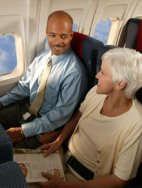
Turbulence: Staying Safe
Updated: 2:58 pm ET January 26, 2009
What is Turbulence?
 Turbulence is air movement that normally cannot be seen and often occurs unexpectedly. It can be created by many different conditions, including atmospheric pressure, jet streams, air around mountains, cold or warm weather fronts or thunderstorms. Turbulence can even occur when the sky appears to be clear.
Turbulence is air movement that normally cannot be seen and often occurs unexpectedly. It can be created by many different conditions, including atmospheric pressure, jet streams, air around mountains, cold or warm weather fronts or thunderstorms. Turbulence can even occur when the sky appears to be clear.
While turbulence is normal and happens often, it can be dangerous. Its bumpy ride can cause passengers who are not wearing their seat belts to be thrown from their seats without warning. But, by following the guidelines suggested on this site, you can help keep yourself and your loved ones safe when traveling by air.
To keep you and your family as safe as possible during flight, FAA regulations require passengers to be seated with their seat belts fastened:
- When the airplane leaves the gate and as it climbs after take-off.
- During landing and taxi.
- Whenever the seat belt sign is illuminated during flight.
Why is it important to follow these safety regulations? Consider this:
- In nonfatal accidents, in-flight turbulence is the leading cause of injuries to airline passengers and flight attendants.
- Each year, approximately 58 people in the United States are injured by turbulence while not wearing their seat belts.
- From 1980 through June 2004, U.S. air carriers had 198 turbulence accidents*, resulting in 266 serious injuries and three fatalities.
- At least two of the three fatalities involved passengers who were not wearing their seat belts while the seat belt sign was illuminated.
- Generally, two-thirds of turbulence-related accidents occur at or above 30,000 feet.
*The National Transportation Safety Board defines an accident as an occurrence associated with the operations of an airplane in which any person suffers death or serious injury or in which the aircraft receives substantial damage.
2:58 pm ET January 26, 2009